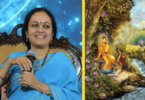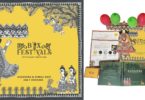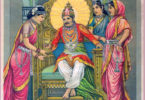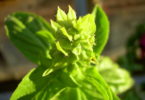Navratri, also spelled Navaratri or Navarathri, is a 9 day long Hindu festival celebrated in almost every part of India. In most parts it is celebrated in honor of the divine Devi – Durga, a re-incarnation of Adi Shakti. In the southern and eastern states of India, the Durga Puja is synonymous with worshiping the Goddess – Navratri, wherein goddess Durga battles and emerges victorious over Mahishasura – the buffalo demon. In the northern and western states, the festival celebrates the battle and victory of god Rama over the demon king Ravana. In both cases, the festival celebrates the victory of the good over evil.
The 9 days of Navratri are dedicated to the worship of 9 forms of the Goddess – Shailaputri, Brahmacharini, Chandraghanta, Kushmanda, Skandamata, Katyayani, Kaalaratri, Mahagauri, Durga or ParaShakti. Here are the stories of each of these Goddesses.
Ma Shailaputri – The Goddess Worshiped on the First Day of Navratri
Ma Shailaputri (Daughter (putri) of Mountain (shaila)) is worshiped on the first day of Navaratra. Shailaputri was the daughter of the God of Mountains, Himalaya. Popularly known as Parvati, her husband is Shiva and she has two sons – Kartikeya and Ganesha. In her previous incarnation, she was Sati – the daughter of a great king, Daksha. According to the legend, Daksha Prajapati was one of the sons of Lord Brahma.
Daksha did not want his daughter, Sati, to marry Shiva as he considered Shiva a dirty ascetic not worthy of marrying a girl from a noble family. Read the Complete Story here.
Ma Brahmacharini – The Goddess Worshipped on Second Day of Navratri
Ma Brahmacharini is the goddess worshiped on the second day of Navratri. It is one of the nine avatars of Goddess Durga. In this avatar, Durga embodies tapa or penance. The name Brahmacharini is derived from two words – “Brahma” here means tapa or penance and “Charini” means an ardent female follower.
After she immolated herself in the sacrificial fire of the yagna, Durga took birth as the daughter of the King of the Mountains, Himavan or Himalaya. She was named Parvati (after the Sanskrit name for mountains – parvat) or Hemavati.
When Parvati grew up, sage Narada – son of Brahma, paid her a visit. He told her that she did have a chance to marry her husband from her previous birth, Lord Shiva, if she followed a path of penance. Determined to marry Shiva in this birth as well, Parvati embarked upon an extremely difficult regime of penance and devotion. Read the Complete Story here.
Ma Chandraghanta – The Goddess Worshipped on the Third Day of Navratri
On the third day of Navratri, the third Power (Shakti) of Goddess Durga is worshipped. This avatar of Goddess Durga is known and worshipped as Ma Chandraghanta (Mother Chandraghanta). Her forehead is bedecked with the crescent moon (Hindi: Chandra) resembling the shape of a temple bell (Hindi: ghantaa).
Upon the insistence of Sage Narada, Parvati, the daughter of Himalaya observed austere penance to get Lord Shiva as her consort. Shiva, after losing Sati, had become detached from worldly affairs and had retired into the mountains in deep meditation, isolation and austerity.
But after seeing Parvati’s resolve to get him, Shiva relents and agrees for the marriage. On the day of marriage, Shiva reaches King’s Himavan’s palace in a most terrorizing form along with the strangest marriage procession. His body is smeared with ash, with snakes around his neck as well as in the matted locks of his unkempt hair. The marriage procession consists of ghosts, ascetics, sages, goblins, ganas, ghouls and aghoris. Upon seeing such a terrorizing form of Lord Shiva and his strange marriage procession, Parvati’s mother and other relatives are left in a state of shock. Most of them faint purely out of terror.
To avoid any embarrassment to her family and to Lord Shiva, Parvati transforms herself into a terrorizing form – Chandraghanta.





Hi Cannot see the 9th Day of Navratri story. Please help with the same. Thanks
Thank you so much for this story ….very great explination